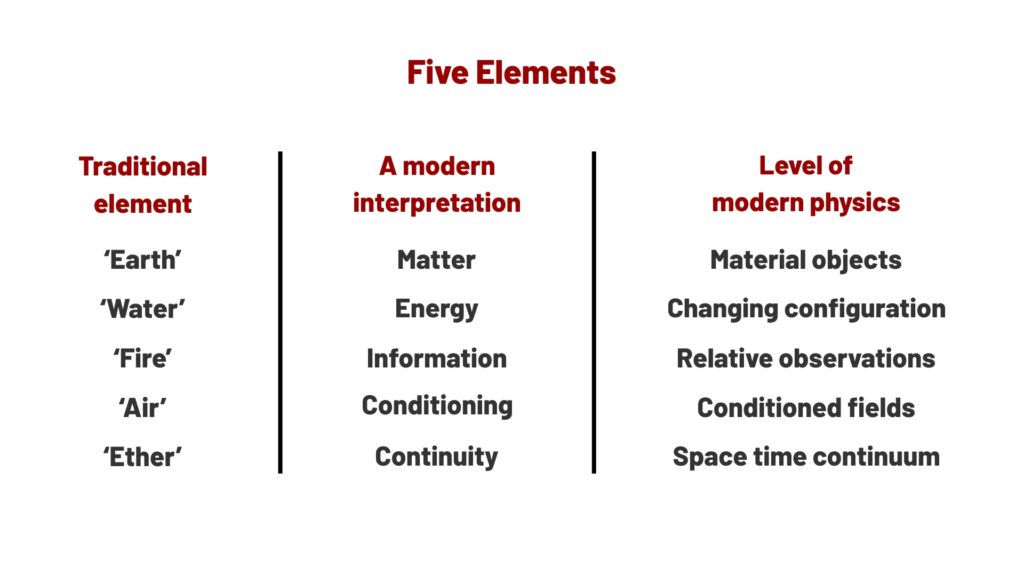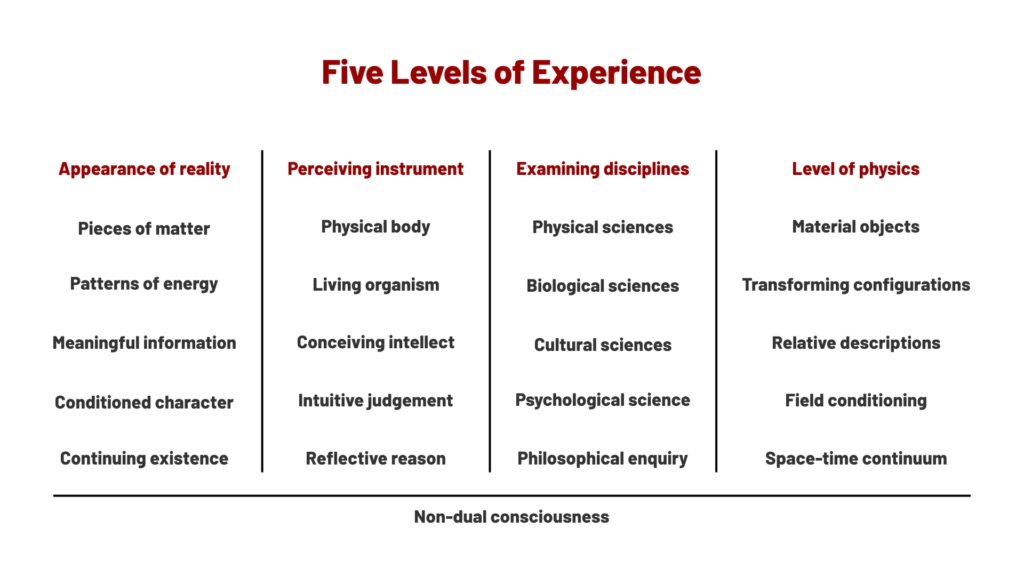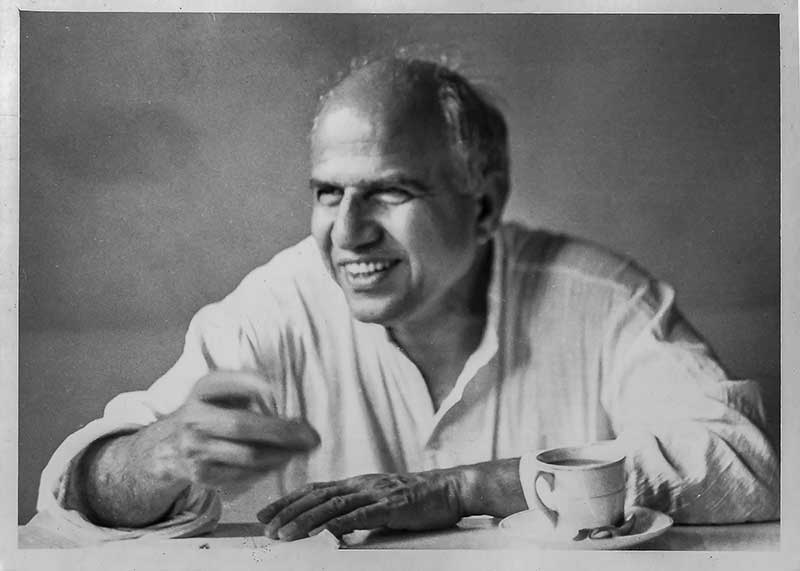- Visitor:22
- Published on:
FIVE LEVELS OF EXPERIENCE
We do not directly observe the matter and energy in the world outside our bodies and our measuring instruments. External matter and energy are only observed through the representations of information that our instruments have received. In this sense, information is more fundamental than matter and energy. In its turn, information depends on something further still. In order to represent anything, information depends upon a comparison of represented conditioning. Thus, beneath the information through which the world appears to us, there is a fourth element: of relative conditioning.

The Traditional Five Elements
What is the world that nature manifests? This question is answered by the traditional conception of ‘five elements’, shared largely in common by Indian and European traditions.
In the Brhadaranyaka Upanisad, there is an early account of these five elements. A lady called Gargi points out that the entire world of earthly things is actually made of the element ‘water’, just as a cloth is woven from thread. What then, she asks, about the element ‘water’? If all things of ‘earth’ turn out to be made of ‘water’, then what is ‘water’ made of?
She is questioning Yajñavalkya, who replies that ‘water’ is made of the underlying element ‘fire’. And what about ‘fire’? In its turn, ‘fire’ is reduced to the underlying element ‘air’. Similarly, ‘air’ is reduced to underlying ‘ether’.
Even by a modern academic dating that may have grossly underestimated the age of ancient traditions, the Brhadaranyaka Upanisad is over two and a half thousand years old. It describes the five elements as a conception that was then already established by ancient custom, handed down from the distant past. For thousands of years, in India and Europe, this conception has been used to progress from the gross particularity of earthly things to the ethereal pervasiveness of space and light throughout the universe. In India, traditionally-minded people still use this conception today.
Like many ancient conceptions, this one is metaphorical. It uses the metaphor of certain physical substances to suggest a subtler and more basic analysis of our experience. But what does the metaphor mean? How might it be interpreted in more abstract, modern terms? Since it is a metaphor that has been used over thousands of years, by many different people, we must expect that it can be interpreted in different ways. In the discussion that follows, one such interpretation is suggested. It is summarized in figure below.
Through our limited senses and minds, we do not see everything at once. Instead, we see particular objects; and we conceive a material world that is made up of many such objects. Each object is a particular piece of matter, divided from other objects by boundaries in space and time. This divisible matter corresponds fairly obviously to the traditional element ‘earth’. In a classical Indian metaphor, the particular objects of the world are conceived to be formed from the element ‘earth’ as pots are formed from clay.

At first, the world of particular objects seems solid. But, upon further investigation, it is not so. As objects interact, they are caught in a constant process of formation and transformation. When changing time is taken into account, our solid-seeming world is shown to be only an instant snapshot: a momentary picture taken at a particular instant of time. As time flows, the objects of the world keep changing. Each moment that we look, what we have seen keeps vanishing, transformed into something else.
Through this examination, the seeming solidity of objects gives way to a fluidity of changing forms. It is then clear that matter is not the only element in our experience of the world. In addition to the concrete particularity of matter, we experience a second, more fundamental element – which may be called ‘energy’. This second element, of energy, is manifested in moving activity; and it thus produces the changing forms of objects in the world. It is associated with the fluidity of change, which makes it correspond to the traditional element called ‘water’.
Through the changing flow of energetic activity, information travels from place to place. This enables us to observe the world. Each observer receives information that represents other things. These represented things are then illuminated by observing them, from a particular point of view.
So, beyond matter and energy, information is a third element of our experience. By representing other things, it throws a particular light on them; and it thus corresponds to the traditional element called ‘fire’.
We do not directly observe the matter and energy in the world outside our bodies and our measuring instruments. External matter and energy are only observed through the representations of information that our instruments have received. In this sense, information is more fundamental than matter and energy.
In its turn, information depends on something further still. In order to represent anything, information depends upon a comparison of represented conditioning. For example, a map shows some places closer together and other places further apart. Or it may show how various places are cooler or hotter: by comparative shades of color, or by numbers that spell out the comparison in a more calculated way.
Thus, beneath the information through which the world appears to us, there is a fourth element: of relative conditioning. It shows the world as conditioned by varying characteristics and qualities, in much the same way that the atmosphere is conditioned by climate. So there is another correspondence here, with the traditional element called ‘air’.
In order to compare the differing characteristics of different places, there has to be an underlying continuity, which extends through space and time. This continuity is understood in a way that is rather different from our perceptions of matter. Where matter is perceived, space and time are distances that separate particular objects and events. Where continuity is understood, space and time are not what separates, but what connects. Here, distance is not separation, but a connection in between. It is the intervening connection between parts of a world that has been made to seem divided, by our limited and narrow perceptions.
Thus, beneath the differentiated conditioning of the world, there is a fifth element, of pervading continuity. This evidently corresponds to the traditional element called ‘ether’. It is described as the subtlest element, pervading the entire world.
A Comparison with Modern Physics
In this kind of way, the ‘five elements’ can be interpreted as different levels, which get mixed up, in our experience of the world. These same five levels can be seen in modern physics.
At the first level, we have Newtonian physics, where the world is described as made up from pieces of matter, which act upon one another through force.
At the second level, physical objects are described as configurations of energy. Here, we have Einstein’s principle that matter is only a concentrated form of energy. And we have quantum systems: as configurations of coordinated activity, which get disturbed by observation and other actions from outside.
At the third level, mass, energy, time and space are seen as relative measurements that depend upon the observer. They are not absolute things in themselves. Instead, they are interdependent components, in the process by which an observer receives and interprets information.
At the fourth level, there are various theories of fields. In physics, the word ‘field’ refers to a ‘conditioned space’. The conditioning is described by attributing a mathematical value to each point of space and time. The idea is to explain phenomena, and to predict occurrences, on the basis of such mathematical descriptions of field conditioning. Relativity and quantum theory have gone a long way in this direction. They use field calculations to describe physical phenomena, in a far more accurate and systematic way than our common sense ideas. And, in building these more accurate descriptions, modern physicists have shown that our common sense assumptions are often wrong. In particular, our notions of separated matter are only approximations, and misleading ones at that. For many everyday purposes, our habitual assumptions work well enough to make us think that they are right. But, upon closer examination, they break down. Then they have to be replaced by rather different ideas, which look deeper into our experience of the world.
At the fifth level of modern physics, there is the space-time continuum. At the end of the nineteenth century, physicists had a somewhat degraded notion of the traditional element ‘ether’. They were puzzled as to how electromagnetic waves, like light, could travel through empty space. So they thought of the ‘ether’ as a special kind of material substance, which invisibly filled all space. Electromagnetic waves were supposed to be carried by material vibrations in this invisible substance, like sound waves travel through vibrations in physical air.
But, as a material substance, the ‘ether’ was rather mystifying. To account for the tremendous speed of light, it had to vibrate extremely fast, like a very hard solid. On the other hand, it was like a very thin fluid, which penetrates through everything. To enable the passage of light, the ‘ether’ had to permeate the vast emptiness of outer space, between the earth and the stars. Similarly, the ‘ether’ had to be present in the empty space of a vacuum tube; and it had to permeate air and water and other sub-stances in which light travels and electromagnetic phenomena take place.
Moreover, as our planet earth moves around the sun, it must move through the ‘ether’, like a ball moves through physical air. Thus, on planet earth, there must be an ‘ether wind’; and this must affect the speed of light, depending on whether the light travels with the wind or against it or across it. But the Michelson-Morley experiment showed that there was no such wind. So something was badly wrong.

Albert Einstein took a rather different approach. He did not think of light and electro-magnetism as the result of any material substance that is somehow added on to space. Instead, he saw that the transmission of light is an essential property of space itself. Light and electromagnetism are not transmitted through any material substance, but through the essential continuity that relates together the different points of space and time. Thus, in place of a material ‘ether’, Einstein developed the conception of a ‘space-time continuum’.
In Einstein’s conception, the mechanics of matter is replaced by a geometry of space and time. The world is no longer pictured through material objects and sub-stances, mechanically acting upon each other in three-dimensional space. Instead, the world is conceived through events – which are related to each other by geometry, in four-dimensional space and time. The geometry connects events, into a space-time continuum. All occurrences and happenings are partial manifestations of this continuum, as it is seen differently by the different observers who travel through it.
This space-time continuum is much truer to the ancient concept of ‘ether’. In India, the word for ‘ether’ is ‘akasa’. It is an old Sanskrit word, which means ‘pervading space’. On the one hand, it is commonly used for the overarching space of sky, beyond the atmosphere. And on the other hand, it is philosophically used for the pervasion of space and time within particular objects and locations: as for example when talking of the ‘akasa’ within a pot, or within a person’s body and mind.
There is, however, a significant difference between modern physics and traditional conceptions of the universe
In modern physics, the field of study is restricted to a physical aspect of experience. This physical aspect is described through mathematical calculations; and the calculations are applied through the development of external technologies, which fabricate instruments and machines for use by our physical bodies.
Traditional conceptions are broader and more comprehensive. They describe both physical and mental aspects of experience. Their descriptions are not restricted to mathematical calculation; and their application is not concerned so much with external instruments as with the cultivation and clarification of human faculties.
In short, traditional conceptions of the world are less dependent than modern physics upon the achievement of external objectives. They are more directly concerned with the education of our living faculties: through a reflection back to an underlying, subjective ground.
[…]
World and Personality
Accordingly, in traditional cosmologies, the whole world’s creation may be described as an arising of the five elements – from an underlying subjectivity. Such a description is given in the Taittiriya Upanisad:
From this same self,
‘ether’ has arisen;
from ‘ether’, ‘air’;
from ‘air’, ‘fire’;
from ‘fire’, ‘water’;
from ‘water’, ‘earth’.

How can we interpret this subjective arising of the world, in modern terms? One such interpretation is summarized in figure (above):
At the level of ‘earth’, reality appears through pieces of matter, perceived by our physical bodies. This is the level specifically studied in physical sciences: like physics, chemistry, geology and astronomy. As modern physics shows, even these sciences uncover deeper levels which require a reflection back into the minds of investigating scientists.
At the level of ‘water’, reality appears through patterns of energy: observed by us as living organisms, who share in the patterns of energy that we observe. This or-ganic level of experience is studied in ‘life’ sciences: like biology and medicine.
At the level of ‘fire’, reality appears through meaningful information, interpreted through our conceiving intellects. This conceptual level of experience is studied in cultural and symbolic sciences: like the history of thought, the anthropology of culture and many of the humanities.
At the level of ‘air’, reality appears through conditioned character and quality, contrasted and compared by our intuitive judgements. This level of comparative conditioning is studied in psychological sciences: like ethics and psychotherapy and sciences of meditation and mind-development.
At the level of ‘ether’, reality appears through the continuity of common existence, discerned and clarified through reflective reason. This is a comprehensive level of experience, where common principles are understood beneath the variations of particular instances and differing phenomena. This comprehensive level is specifically studied in philosophical disciplines, through their sceptical questioning of superficial appearances and accepted beliefs that are usually taken for granted. But philosophical enquiry is not restricted to any particular discipline or group of disciplines. It occurs essentially in all disciplines: whenever something is found not to fit into current ideas so that there is a questioning of underlying principles.
Underlying all levels of appearance, the Hindu tradition identifies an unchanging ground of consciousness. This is not a level of appearance, but reality itself – where all appearances are found dissolved.
Thus, the five elements are treated as showing a division of apparent experience, supported by an underlying ground. The division is called ‘pañci-karana’ or ‘making five’. When this division is applied to the manifested universe as a whole, it results in the five elements (called the ‘pañca-mahabhutas’). But the same division may also be applied to other fields of experience.
In particular, when applied to the personality that perceives the world, this fivefold division gives rise to the ‘pañca-kosas’ or ‘five coverings’ of personality:
The outermost covering is the ‘annamaya-kosa’, or the ‘covering of food’. It is the material body: made of the element ‘earth’, and perceiving a world of material objects outside.
Proceeding inwards, the second covering is the ‘pranamaya-kosa’, or the ‘covering of living energy’. This describes a layer of personality that may be conceived as a living organism, functioning through purposeful activity. It is made of the element ‘water’, and it observes a functioning world of purposeful energy and activity.
The third covering is the ‘manomaya-kosa’, or the ‘covering of mind’. It is the conceiving intellect: made of the element ‘fire’, and interpreting an intelligible world of meaningful information.
The fourth covering is the ‘vijñanamaya-kosa’ or the ‘covering of discernment’. This describes the discerning sensibility of intuitive judgement. It is made of the element ‘air’, and it carries out the contrasts and comparisons that show a qualita-tive world of motivating value.
The innermost covering is the ‘anandamaya-kosa’, or the ‘covering of happiness’. It is made of the element ‘ether’, and it enables an integrated understanding of common and continuing principles.
Within these five coverings of personality, there is the pure consciousness of knowing self – which is at once each person’s inmost centre and the supporting ground of everything perceived in the objective world.
Similarly, there is a fivefold division of mind: into ahankara or ego, citta or will, buddhi or intellect, manas or sensibility, and antahkarana or understanding. (Literally, ‘antahkarana’ is the ‘inner faculty’.) Further, there are five pranas or vital functions (prana or forward functioning, apana or reactive functioning, udana or aspirational functioning, vyana or disseminating functioning, and samana or assimilative function-ing). There are five senses of perception (smell, taste, sight, touch and sound: corresponding in that order to ‘earth’, ‘water’, ‘fire’, ‘air’ and ‘ether’). And there are five faculties of action (upastha or reproduction, payu or expulsion, vak or expression, pada or movement, and pani or holding – the order is rather uncertain).
These fivefold divisions are used – together with the threefold division of nature’s constituting qualities – in various cosmological and psychological descriptions. But it is understood that they all arise from a subjective ground to which they must keep on returning, continually, in order to resolve their differences.
Source : Ways to Truth, Anand Wood, D.K. Print World Ltd
- 11 min read
- 0
- 0










